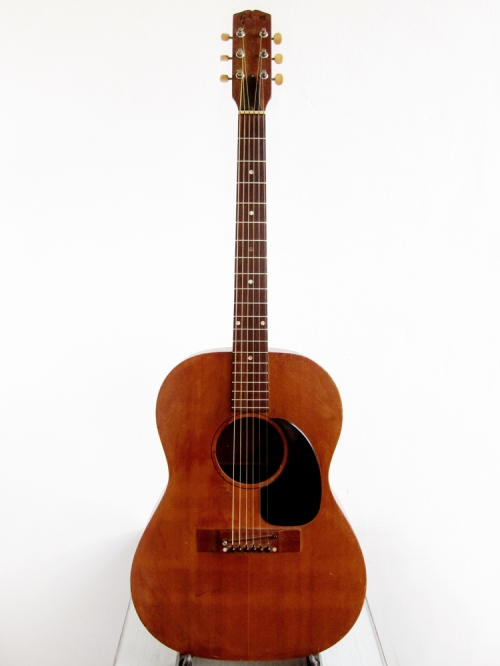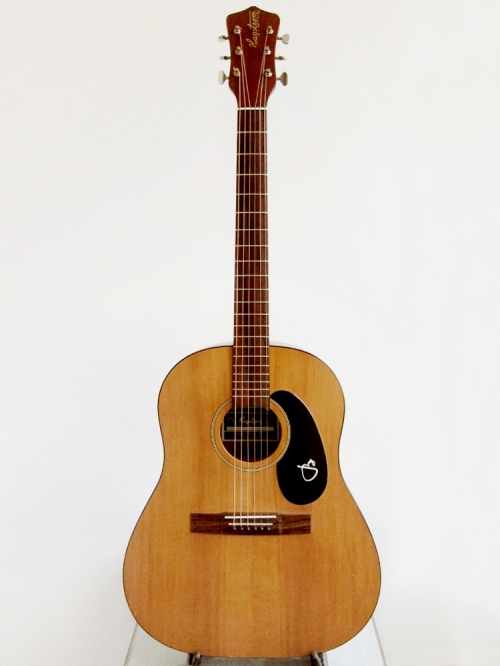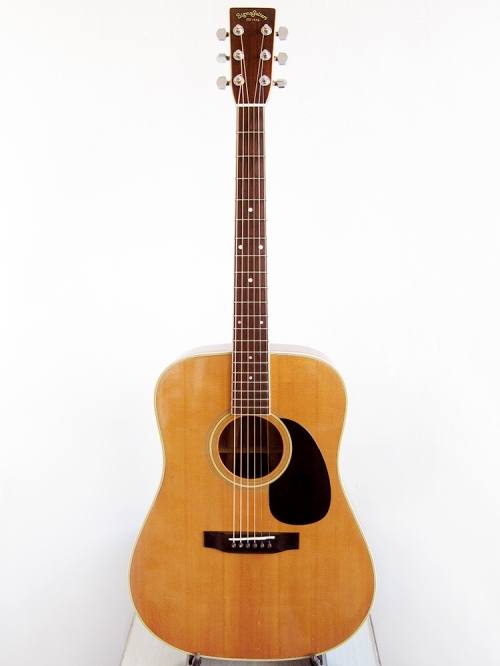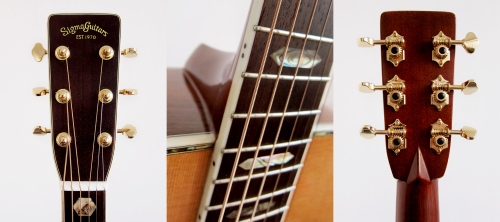 Martin SPD-16R, Made in USA 1999,
Martin SPD-16R, Made in USA 1999, 1500€ SOLD
Martin SPD-16R is a Special Edition Dreadnought from Martin guitars. Spruce top and Indian Rosewood back and sides with forward shifted scalloped X bracing. Performance taper, low oval mahogany neck with rosewood fretboard and bridge. Snowflake inlays, abalone rosette and a D-45 style back strip with gold Martin stamped machine heads. Produced in USA between 1996-2001. The guitar is in fantastic shape for being 18 years old with hardly any scratches and no fretware. The top has a hairline crack from the bridge down which has cracked the lacquer but not the wood. SPD-16R stands for Special edition, Dreadnought, 16-series in Rosewood. This guitar looks great and sounds amazing, you can read more about it here and listen to it in this Youtube clip.
 Gibson J-45 adj, Made in USA 1965,
Gibson J-45 adj, Made in USA 1965, 2300€ SOLD
An awesome looking Gibson J-45 ADJ, built in the Kalamazoo factory in 1965. It’s the classic round shouldered Gibson dreadnought, natural finish spruce top, mahogany back and sides, rosewood fretboard and bridge. All original except for the refinish which turned this J-45 in to a J-50. Apparently this was done in the early 1970’s when the slight separation in the tops mid seam was glued. The guitar looks really great, worn but still well preserved for being 50 years old. The sound is just amazing, it has that typical Gibson bass response that you can hear on the early records of James Taylor and Jackson Browne. I cut a new bone saddle for it but it comes with it’s original adjustable rosewood bridge. It has an endpin jack already installed so it’s ready to play live, just ad a pickup. A brand new flight case is included to protect the guitar. The action is low and there are no structural issues with this guitar, just the normal marks and scratches. You can read more about the guitar here and listen to it in this Youtube clip.
 Gibson B-15, Made in USA 1969,
Gibson B-15, Made in USA 1969, 1200€ SOLD
This 1969 Gibson B-15 sounds and plays great and is pretty good shape for it’s age. There is a lot of scratches and wear to the top and sides but the are no cracks or structural issues. It’s all original and even comes with the Gibson made alligator chipboard case. The action is good and the frets has very little wear. The B-15 was an all solid model with a natural finished mahogany body, a mahogany stained spruce top and rosewood fretboard and bridge. Gibson referred to the B-series as student models at the time which is a bit misguiding considering what a student guitar sounds like today. These have great even tone and pretty amazing sustain for the size, a perfect little blues machine. You can read more about the guitar here and listen to it in this Youtube clip.
 Harmony Monterey H1325, Made in USA 1950’s,
Harmony Monterey H1325, Made in USA 1950’s, 550€ SOLD
Very cool looking US made archtop from the late 1950’s. Solid spruce top with birch back and sides, 16 1/2 in wide grand auditorium size, steel reinforced neck. This guitar is all original and even comes with the original case. There is a glued crack on the side but no other issues. It sounds great, loud and clear acoustically. You can read more about the guitar here and listen to it in this Youtube clip.
 K. Yairi YW-1000, Made in Japan 1973,
K. Yairi YW-1000, Made in Japan 1973, 1700€ SOLD
This is the top of the line, the fanciest guitar that K. Yairi built. Their Martin D-45 copies are legendary for their sound and build quality. This guitar has real Brazilian Rosewood back and sides and a beautifully aged solid spruce top. Real abalone inlays all around and the typical Martin volute where the head and neck meet. At the moment this guitar has Wilkinson WJ28NGD open gear machine heads in gold fitted but I still have the original K. Yairi machine heads. It’s all original except for the bridge which is a brand new hand cut and shaped replacement in ebony with a bone saddle and ebony bridge pins. The guitar is in great shape for being 43 years old but there are a couple of scratches to the top, one big one close to the bottom. The neck is straight, trussrod works and the action is low. The guitar sounds amazing, so deep and clear at the same time. These K. Yairi YW-1000 are extremely rare in Europe and without any doubt the closest you can get to a real 1970’s Martin D-45. You can read more about the guitar here and listen to it in this Youtube clip.
 Morris W-50, Made in Japan 1970’s,
Morris W-50, Made in Japan 1970’s, 700€ SOLD
Nice Martin D-42 copy with real abalone hexagon inlays and the typical Martin volute where the head and neck meet. Solid spruce top with nice inlays all around and a beautiful 3-piece back with flamed maple and dark rosewood. The guitar is all original and in really good shape for being over 35 years old but with some scratches, one slightly larger on the top. The neck is straight, trussrod works and the action is low. The guitar sounds great, very clear and Martin like. You can read more about the guitar here and listen to it in this Youtube clip.
 Morris W-50, Made in Japan 1970’s,
Morris W-50, Made in Japan 1970’s,650€ SOLD
Great looking Martin D-42 copy with snowflake inlays and the typical Martin volute where the head and neck meet. Solid spruce top with nice inlays all around and a beautiful 3-piece back with flamed maple and dark rosewood. The guitar is all original and in really good shape for being over 35 years old but with scratches and marks around the body. It has Wilkinson WJ28NGD open gear machine heads in gold installed now but the original will be included. The neck is straight, trussrod works and the action is low. The guitar sounds great, very clear and Martin like. You can read more about the guitar here and listen to it in this Youtube clip.
 Morris W-40, Made in Japan by Terada 1973,
Morris W-40, Made in Japan by Terada 1973, 500€ SOLD
A pretty early Morris and a very nice looking Martin D-45 copy, made by Terada in Japan, the factory that makes Gretsch and Orville. Solid spruce top with a really nice 3-piece back of Brazilian rosewood and maple. The inlays are real abalone hexagon inlays and I still have the original machine heads if chrome is preferred to gold. It has it’s fair share of scratches and has been played a lot over the past 42 years but it has no cracks or issues. The neck is straight, trussrod works and the action is low. The sound is just amazing, really deep bass but with good clarity and great projection. It has a endpin jack fitted and a strap button so it’s ready to be gigged with straight away, just fit a pickup. It’s still one of my favourites but now I have too many Morris guitars and have to get rid of some. You can read more about the guitar here and listen to it in this Youtube clip.
 Morris WL-35, Made in Japan 1970’s,
Morris WL-35, Made in Japan 1970’s, 400€ SOLD
A really cool looking Johnny Cash Guild copy. It’s in great condition except for one flaw, the end pin has been pushed in at one point and cracked the lacquer. It’s not as bad as it sounds and it doesn’t really affect anything but I thought it would be worth mentioning. I’m pretty sure it’s mahogany back and sides, it has a really warm and nice sound and is a great playing guitar. It has a endpin jack fitted and a strap button so it’s ready to be gigged with straight away, just fit a pickup. You can read more about the guitar here and listen to it in this Youtube clip.
 K. Yairi TG-40, Made in Japan 1977,
K. Yairi TG-40, Made in Japan 1977, 700€ SOLD
A very rare and unique K. Yairi copy of the famous Guild D-40, which itself was introduced in the Sixties as a competitor to Gibson’s J-45. The Guild D-40 became famous as the Bluegrass guitar for their even response over all the strings and I have to say that this K. Yairi TG-40 sounds amazing. Solid spruce top, sides and back in solid mahogany, neck in Honduras mahogany, bridge and Fretboard in black ebony. The guitar is all original except for the pickguard, which was replaced with an official Guild pickguard, the old one was cracked. It has an end pin jack and strap button fitted and at the moment Wilkinson WJ-309 Art Deco machine heads in gold but I still have the original machine heads if chrome is preferred to gold. The top and back has a few scratches but no structural issues. It plays really well and has an amazing tone, very loud and clear with a great punch in the mid-range. You can read more about the guitar here and listen to it in this Youtube clip.
 K. Yairi YW-130, Made in Japan 1977,
K. Yairi YW-130, Made in Japan 1977, 550€ SOLD
This is a quite accurate Martin D-28 copy made in Japan by K. Yairi in 1977. It’s really light and beautiful sounding, very responsive and a joy to play. Solid spruce top, rosewood back and sides with a smooth ebony fretboard. It has it’s fair share of scratches and a couple of dents to the top but no cracks or issues. The neck is straight, trussrod works and the action is low. The sound is great, very clear with great harmonics. It has a strap button fitted and at the moment Wilkinson open back machine heads in gold but I still have the original machine heads if chrome is preferred to gold. You can read more about the guitar here and listen to it in this Youtube clip.
 Levin Model 13 Ambassadör, Made in Sweden 1950,
Levin Model 13 Ambassadör, Made in Sweden 1950, 600€ SOLD
This is a beautiful Levin Model 13 Ambassadör, hand built in Gothenburg Sweden in 1950. If you are not familiar with this classic Swedish brand Levin, click on the link to read more about it. It was restored a few years ago by GammelGura, a great luthier in Örnsköldsvik, Sweden. With new bronze frets, a neck re-set, cracks glued and a new bridge was created to improve the intonation, the rest is all original. It even has the sticker on the back of the head from the guitar shop in Örnsköldsvik where the guitar was bought 65 years ago. It’s a fairly small ladder braced 12-fret guitar with a big sound because of the body width, 400 mm. All solid woods, as always with Levin. Spruce top, walnut back and sides, 4-ply bound top, single-bound back. Mahogany neck with non-adjustable T-shaped duraluminum truss rod. Single-bound rosewood fingerboard with 18 frets and pearloid dot inlay. Single-bound headstock, rosewood bridge, nickel plated individual tuners. Sunburst finish, very similar to the Gibson sunburst of the 1940-50’s, and 10 years warranty. You can read more about the guitar here and listen to it in this Youtube clip.
 Levin Model 65, Made in Sweden in 1942,
Levin Model 65, Made in Sweden in 1942, 550€ SOLD
A nice little parlour guitar from Levin, made during World War II in Gothenburg Sweden. It’s just 315 mm wide so it’s a perfect little ladder braced blues machine. All solid woods, spruce top, birch back and sides with walnut fretboard, brass machine heads and nickel plated tailpiece. The guitar is all original, I carved a new bridge for lowering the action but the original will be included in the sale. The neck is really fat and nice and feels great to play. A perfect parlour for blues picking. You can read more about the guitar here and listen to it in this Youtube clip.
 Hagström Western 6, Made in Sweden in 1978,
Hagström Western 6, Made in Sweden in 1978, 650€ SOLD
A very rare Hagström Western 6 Missouri made in 1978 by Bjärton in Bjärnum in the south of Sweden. Bjärton were the second largest guitar manufacturers in Sweden after Levin, and they produced all the acoustic instruments for Hagström. It’s both stunning to look at, a joy to play and it sounds great. It has the same head, fretboard and inlays as the legendary Hagström Suede electric guitars had in the 1970’s. Spruce top with X-bracing, mahogany back and sides. 4-ply bound top and bound back. Unbound ebony fingerboard, rosewood bridge, mahogany neck. Matte natural finish and 10 year warranty, which was only give to the top end models. You can read more about the guitar here and listen to it in this Youtube clip.
 Hagström B-60, Made in Sweden by Bjärton in 1975,
Hagström B-60, Made in Sweden by Bjärton in 1975, 500€ SOLD
This great looking Gibson J-50 copy was made in 1975 by Bjärton in Bjärnum in the south of Sweden. Bjärton were the second largest guitar manufacturers in Sweden after Levin, and they produced all the acoustic instruments for Hagström. It’s made out of all solid woods and it’s a very nice sounding guitar, even though it has a bolt-on neck, I guess the solid woods and massive neck block is helping with the sound. Spruce top with X-bracing, mahogany back and sides with a nice mahogany bolt-on neck, unbound rosewood fingerboard, Single-bound top and back, rosewood pin bridge. Van Gent machine heads, just like Levin, natural finish and 10 year warranty, which was only give to the top end models. You can read more about the guitar here and listen to it in this Youtube clip.
 Sigma DR-35, Made in Japan 1980
Sigma DR-35, Made in Japan 1980
 This guitar had apparently been in storage for the last 30 years, since the original owner died and that seems plausible, it’s in really good shape for it’s age.
This guitar had apparently been in storage for the last 30 years, since the original owner died and that seems plausible, it’s in really good shape for it’s age. The classic Made in Japan football stamp, burnt in to the back brace that was used from 1978-1983 on Japan made Sigma’s stating: Sigma Guitars – Made in Japan for – C.F. Martin & Co, just like on mySigma DR-41. The rosewood looks really nice on this Sigma, even better than on mine.
The classic Made in Japan football stamp, burnt in to the back brace that was used from 1978-1983 on Japan made Sigma’s stating: Sigma Guitars – Made in Japan for – C.F. Martin & Co, just like on mySigma DR-41. The rosewood looks really nice on this Sigma, even better than on mine. The original receipt from 26 September 1980. The guitar cost 475 Deutsche Mark which would be around 245€ today and probably a lot more 36 years ago. Taken from my Instagram
The original receipt from 26 September 1980. The guitar cost 475 Deutsche Mark which would be around 245€ today and probably a lot more 36 years ago. Taken from my Instagram









 Martin SPD-16R
Martin SPD-16R



 Morris W-50
Morris W-50




 Levin Model 65
Levin Model 65






 I thought about getting a pre-made
I thought about getting a pre-made 
 I glued the bridge on and after 3 days I strung up both E-strings and used a drill as a saddle so I could move it around until I got the intonation right, I forgot to take a picture of that. I marked out the saddle and then sawed a 3 mm slot. Next step was to create a bone saddle to match and string it up. Easy peasy, well it was a hard days work but it was easier that I thought.
I glued the bridge on and after 3 days I strung up both E-strings and used a drill as a saddle so I could move it around until I got the intonation right, I forgot to take a picture of that. I marked out the saddle and then sawed a 3 mm slot. Next step was to create a bone saddle to match and string it up. Easy peasy, well it was a hard days work but it was easier that I thought. 





 A changed the bridge pins and put in a bone saddle, straightened up the neck and polished the frets. There was a pretty nasty dent on the back of the neck, close to the body, that I filled, painted and lacquered over.
A changed the bridge pins and put in a bone saddle, straightened up the neck and polished the frets. There was a pretty nasty dent on the back of the neck, close to the body, that I filled, painted and lacquered over.

 Luxor 42-274, made in the Matsumoku factory in Japan by Ibanez in the 1970’s. Imported to Germany by Musikhaus Otto Manfred Hack in Göttingen
Luxor 42-274, made in the Matsumoku factory in Japan by Ibanez in the 1970’s. Imported to Germany by Musikhaus Otto Manfred Hack in Göttingen